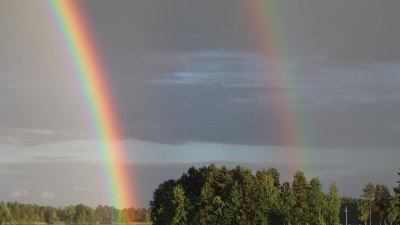The Science Behind Double Rainbows
Explore the fascinating science of double rainbows, their formation, and the physics behind this stunning phenomenon.

A double rainbow is one of nature's most beautiful spectacles, a mesmerizing display of colors that captures the imagination and inspires awe. This enchanting phenomenon occurs when sunlight interacts with raindrops in a specific way, creating two concentric arcs of colors in the sky. To understand the science behind double rainbows, we must delve into the principles of light refraction, reflection, and dispersion.
The Basics of Rainbow Formation
Before we can explore double rainbows, it’s important to understand how a single rainbow forms. A rainbow is created when sunlight passes through raindrops suspended in the atmosphere. As sunlight enters a raindrop, it slows down and bends, a process known as refraction. The light is then reflected off the inside surface of the raindrop before it exits and refracts again. This bending and reflection of light break it into its individual colors, creating a spectrum that we see as a rainbow. The primary colors of a rainbow, in order from the outer arc to the inner arc, are red, orange, yellow, green, blue, indigo, and violet.
Understanding Double Rainbows
A double rainbow occurs when the light undergoes two reflections inside the raindrop instead of just one. The first arc is brightly colored and is referred to as the primary rainbow, while the second, fainter arc is known as the secondary rainbow. This secondary arc appears outside the primary rainbow and has its colors reversed; red is on the bottom and violet is on the top. The presence of both rainbows occurs under specific conditions: there must be sufficient moisture in the air, and the sun must be shining from behind the observer at a low angle.
The Physics of Double Rainbows
To truly appreciate the science of double rainbows, we can examine the physics involved. The process begins with sunlight entering a spherical raindrop. The angle at which light enters the droplet significantly influences the resulting angle of the colors. For a primary rainbow, light typically exits the raindrop at an angle of approximately 42 degrees relative to the incoming light. However, for a secondary rainbow, light exits at an angle of about 50 degrees, which is why it sits outside the primary arc.
The dual reflection of light within the droplet results in a decrease in the intensity of the colors observed in the secondary rainbow. Each reflection causes some light to be absorbed by the droplet, resulting in a fainter secondary arc. As a result, secondary rainbows are often less vivid and can appear washed out compared to primary rainbows.
Color Order in Rainbows
The reversed color order in secondary rainbows may come as a surprise to some. In a primary rainbow, the order of colors is red on the outer edge and violet on the inner edge. However, the angles of light refracted and reflected in the droplet result in the opposite order for the secondary rainbow. The sequence for the secondary rainbow starts with violet on the outer edge and red on the inner edge. This phenomenon occurs because the red light, which has a longer wavelength, is refracted less than violet light, which has a shorter wavelength.
Conditions Favorable for Double Rainbows
Double rainbows are relatively rare compared to single rainbows, and specific conditions must be met for their formation. First and foremost, sunlight needs to illuminate the raindrops while the observer is situated with their back toward the sun, allowing them to see the resulting arcs. Additionally, the size of the raindrops plays a crucial role; larger raindrops tend to produce more vivid rainbows, while smaller ones can result in pale or diffuse arcs. Cloud cover, geographical location, and the time of day can also influence the likelihood of observing a double rainbow. Generally, the best time to spot a rainbow is after a rain shower when the sun reemerges as the moist air begins to settle.
Symbolism and Cultural Significance
Throughout history, rainbows have played a significant role in various cultures and mythologies. Rainbows are often viewed as symbols of hope, promise, and transformation. In Judeo-Christian tradition, the rainbow is seen as a covenant between God and humanity, as mentioned in the story of Noah's Ark. Many cultures celebrate rainbows as a bridge connecting different realms—between earth and heaven, life and death, or human and divine. In literature and art, rainbows are depicted as symbols of peace and beauty, while in other contexts, they may represent duality and contradiction.
The Science of Perception
Interestingly, the perception of double rainbows is more than just a scientific phenomenon; it also involves the human experience. Observers may react differently based on their personal and cultural contexts, affecting their appreciation of the colors. The intensity and clarity of the rainbows can deeply impact emotions and inspire creativity. Some may experience a sense of enchantment, while others may feel reflective or contemplative in their presence. This interplay between science and perception makes the study of double rainbows an excellent example of how the natural world can find harmony with human emotions and experiences.
Photography and Double Rainbows
The captivating nature of double rainbows makes them a popular subject for photography. Photographers often wait for the perfect conditions to capture these stunning displays. Various techniques can enhance the quality of rainbow photographs, including using polarizing filters to reduce glare and enhance color saturation. The best time to photograph a rainbow is when the light is at its most dramatic, typically during the hours around sunrise or sunset. Additionally, capturing the rainbow in juxtaposition with other elements such as landscapes, water reflections, or urban settings can yield striking and memorable images.
Beyond Double Rainbows: Other Optical Phenomena
While double rainbows are among the most celebrated optical phenomena, there are other fascinating occurrences in the atmosphere that similarly arise from light interacting with water droplets or ice crystals. For instance, halos, sun dogs, and coronas are examples of atmospheric optical phenomena that manifest under different conditions. Halos are rings of light that form around the sun or moon due to ice crystals in the atmosphere, while sun dogs are bright spots that appear on either side of the sun. Each of these phenomena highlights the intricate interplay between light and the atmosphere, showcasing the beauty found in nature.
Double rainbows embody a beautiful intersection of meteorology, physics, and human emotion. While the scientific principles behind their formation may be complex, the enchantment they inspire is universal. Observing a double rainbow serves as a reminder of the beauty of nature and the wonder of the world around us. Whether viewed from a scientific perspective or a more artistic one, double rainbows continue to capture the fascination of people across cultures and generations. So the next time you encounter a double rainbow, take a moment to appreciate not only its beauty but also the remarkable science that lies behind it.











